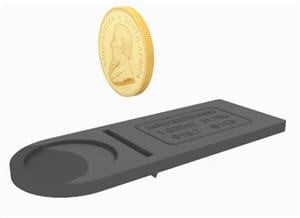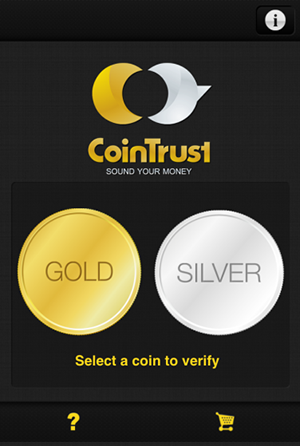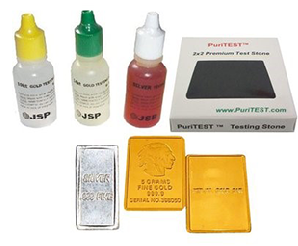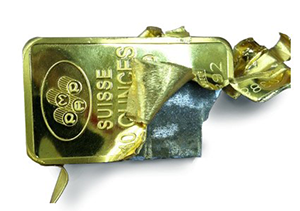by Precious Metals Market Update
Just about all bullion investors worry about counterfeits. Those concerns are magnified when someone is buying for the first time. Stories about fake coins from Asia and gold bars drilled and filled with Tungsten have been in the headlines recently. But the truth is, counterfeiting is just about as old as the concept of money itself.
Some testing equipment, such as mass spectrometers and sonogram machines, are expensive and impractical for the typical person to use. However, here are some lower budget ways you can determine whether or not the bullion you hold is genuine:
Size and Weight
Gold and silver are extraordinarily dense metals – much denser than
just about any base metal, including lead. That means just about all
fakes that weigh correctly will be too large in diameter and/or
thickness. Or they will be underweight in order to achieve the right
diameter and thickness. Simply comparing the diameter and thickness of
the coin in question with others known to be genuine could be enough to
put you at ease.
If not, an inexpensive set of calipers and a jeweler’s scale are a good way of checking. Every coin or round is produced with close tolerances in terms of diameter, thickness, and weight. You can find these dimensions on the “Specifications” tab on our coin and round product pages.
Investors might also consider Fisch Testers. Genuine coins will be both small enough in diameter and thin enough to fit through a slot in the tool, while remaining heavy enough to tip the tool on its fulcrum. Simple and very effective.
Sound or “Ping” Testing
Try balancing the coin on your fingertip and strike it with another coin. Thisvideo provides a good demonstration.
Investors with an iPhone can also install the CoinTrust application and test a short list of the most popular gold and silver coins by gently spinning them on a hard surface with the phone’s microphone positioned nearby.
Magnetism
The above video on ping testing also references another simple technique for using a magnet to identify fakes. Gold and silver are non-magnetic. Placing a strong magnet on a coin and tipping it to watch whether the magnet slides off, as it should, or sticks, like it would to a counterfeit, requires only an inexpensive magnet and a few seconds. (Note that some base metals used in counterfeiting are also non-magnetic, so we suggest doing this in conjunction with some other techniques listed.)
Thermal Conductivity Testing for Silver
Silver is one of the best conductors of thermal energy found in nature. That makes it easy to test silver bullion using nothing more than an ice cube. Place an ice cube on top of a coin, round, or bar, and you should see it begin melting almost instantly as heat is quickly transferred. Holding a coin or round between fingers or in the palm of your hand makes the results even more noticeable as the silver rapidly cools to your touch.
Acid Testing
A Word about Tungsten Fakes
Some of the hardest to detect counterfeit gold products involve tungsten. Tungsten’s density is close to that of gold, and it is relatively inexpensive. Here are some of the best ways to avoid problems:
Recently some of the more prominent mints and refiners have begun
employing technology to mark products with seals that assure
authenticity. For example, Sunshine Minting rounds and bars carry a seal that reads “VALID” when viewed using their proprietary lens and oriented correctly.
Read more at http://investmentwatchblog.com/simple-home-tests-to-determine-whether-your-bullion-is-real-or-fake/#q3FbMlDymjLBtLfp.99
Just about all bullion investors worry about counterfeits. Those concerns are magnified when someone is buying for the first time. Stories about fake coins from Asia and gold bars drilled and filled with Tungsten have been in the headlines recently. But the truth is, counterfeiting is just about as old as the concept of money itself.
Before diving into all the ways that fakes can be
detected, the first and best protection is to work with a reputable and
knowledgeable dealer such as Money Metals Exchange. Recently voted “Best in the USA,”
Money Metals has high quality control and internal screening standards,
plus it stands behind the metals that it sells to customers.
Fortunately, making phony coins or bars isn’t easy. The equipment
involved is significant – it takes far more than a color printer and the
right paper. And making fakes good enough to pass a few simple tests is
darn near impossible.Some testing equipment, such as mass spectrometers and sonogram machines, are expensive and impractical for the typical person to use. However, here are some lower budget ways you can determine whether or not the bullion you hold is genuine:
Size and Weight
|
If not, an inexpensive set of calipers and a jeweler’s scale are a good way of checking. Every coin or round is produced with close tolerances in terms of diameter, thickness, and weight. You can find these dimensions on the “Specifications” tab on our coin and round product pages.
Investors might also consider Fisch Testers. Genuine coins will be both small enough in diameter and thin enough to fit through a slot in the tool, while remaining heavy enough to tip the tool on its fulcrum. Simple and very effective.
Sound or “Ping” Testing
|
Authentic gold and silver coins chime when struck
and the difference is notable versus base metals. (For more about the
melodic Ring of Truth you hear in Sound Money, read Guy Christopher’s essay here.)
Base metal coins will sound duller and their ring will be shorter —
much like the difference between clinking crystal versus glass champagne
flutes.Try balancing the coin on your fingertip and strike it with another coin. Thisvideo provides a good demonstration.
Investors with an iPhone can also install the CoinTrust application and test a short list of the most popular gold and silver coins by gently spinning them on a hard surface with the phone’s microphone positioned nearby.
Magnetism
The above video on ping testing also references another simple technique for using a magnet to identify fakes. Gold and silver are non-magnetic. Placing a strong magnet on a coin and tipping it to watch whether the magnet slides off, as it should, or sticks, like it would to a counterfeit, requires only an inexpensive magnet and a few seconds. (Note that some base metals used in counterfeiting are also non-magnetic, so we suggest doing this in conjunction with some other techniques listed.)
Thermal Conductivity Testing for Silver
Silver is one of the best conductors of thermal energy found in nature. That makes it easy to test silver bullion using nothing more than an ice cube. Place an ice cube on top of a coin, round, or bar, and you should see it begin melting almost instantly as heat is quickly transferred. Holding a coin or round between fingers or in the palm of your hand makes the results even more noticeable as the silver rapidly cools to your touch.
Acid Testing
|
Investors can purchase inexpensive acid test kits
for gold and silver. Watching the color change in a drop of acid can
reveal whether or not a sample is genuine. However, acids should be
handled carefully. Your items can be permanently discolored.
Since bullion coins, rounds, and bars are valued for their metal
content, not their beauty, discoloration is unlikely to reduce the value
of your bullion by more than a small amount. But it’s still wise to use
acid testing sparingly and with caution.A Word about Tungsten Fakes
Some of the hardest to detect counterfeit gold products involve tungsten. Tungsten’s density is close to that of gold, and it is relatively inexpensive. Here are some of the best ways to avoid problems:
- Avoid large gold bars. 10-ounce and larger gold bars are among the easiest to tamper with as they can be drilled, filled with tungsten, and then plugged again with gold. This is more difficult with units 1 oz and smaller. Tungsten is extraordinarily hard whereas gold is soft. This means tungsten is very difficult to use in minting or fabricating small items. It is brittle, and stamping it with a design will result in coins with less detail unless it has been plated with a thick layer of gold.
- Ring testing as outlined above should still offer defense against tungsten fakes.
- If the deal is too good to be true, it probably is. Never buy gold bullion below its melt value unless you know and trust its origins.
- Buy silver. No metal shares a similar density to silver, making it even more difficult to make good counterfeits than with gold. Plus, the financial incentive is lower.
|
Investors can expect this sort of technology to be
more widely used in the coming years. (Note: the lens carries a cost of
around $20.00 and needs to be purchased separately from the metal
itself.)
As mentioned above, the best defense against fake bullion is to buy from a reputable dealer. Money Metals Exchange
sources products directly from well-regarded mints and refiners and
employs good quality controls. That is why we can confidently stand
behind every product we sell – guaranteeing authenticity, weight, and
purity.Read more at http://investmentwatchblog.com/simple-home-tests-to-determine-whether-your-bullion-is-real-or-fake/#q3FbMlDymjLBtLfp.99




No comments:
Post a Comment